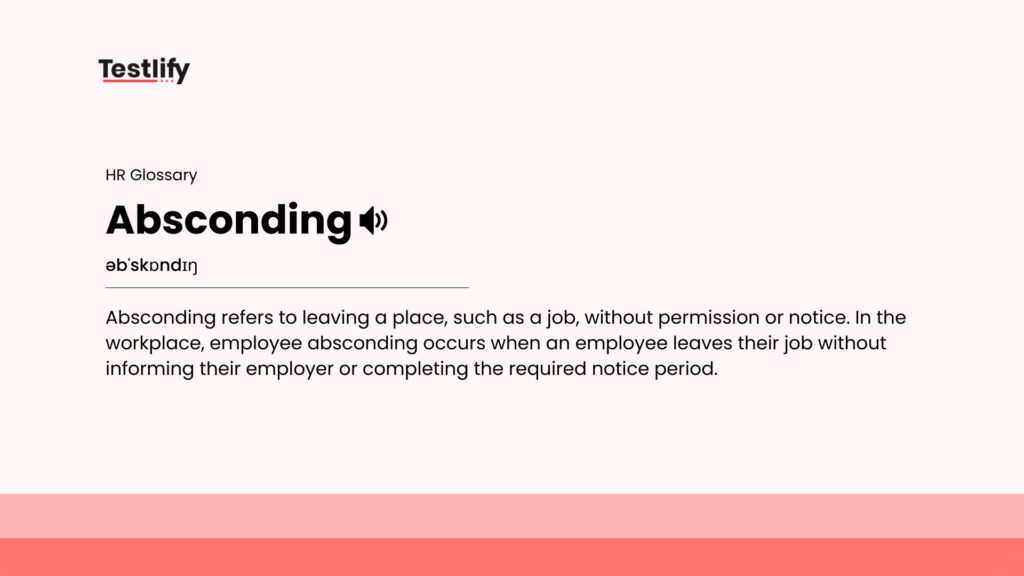What is absconding?
Absconding refers to leaving a place, such as a job, without permission or notice. In the workplace, employee absconding occurs when an employee leaves their job without informing their employer or completing the required notice period.

This can disrupt operations and lead to additional costs for the organization, such as hiring and training a replacement. For the individual, it can damage their reputation and make it harder to find future employment.
To prevent absconding, it’s essential to have clear policies and procedures in place. Employers can create a positive work environment where employees feel valued and respected, reducing the likelihood of absconding. This includes recognizing and rewarding employees, ensuring they feel comfortable discussing issues, and maintaining a supportive positive work culture. In healthcare settings, leaving a hospital without being discharged is also considered absconding and can have serious consequences for the patient’s health.
Implementing these strategies helps organizations manage absconding and promote a more engaged and committed workforce.
What does absconded mean?
Absconded means leaving a place, like a job or hospital, without telling the proper authorities or following the rules. In a job setting, it’s when an employee leaves their place of work without giving the required notice period as stated in their employment contract. This can cause problems for employers, disrupting work and affecting the team.
What are the consequences of absconding?
Absconding is significant for several reasons:
- Reputation: Leaving a job or commitment without notice can harm your reputation, making future employment difficult.
- Unfinished duties: It leaves responsibilities incomplete, causing disruption and inconvenience for others.
- Impact on others: It can negatively affect others, leading to operational disruptions or extra costs for employers.
- Trust and accountability: It damages trust and accountability within an organization.
To maintain a positive work environment, it’s crucial to follow proper procedures, including honoring the notice period outlined in the employment contract. Organizations should have clear policies and procedures in place to prevent absconding and promote a positive work culture.
What steps can organizations take to prevent absconding?
Organizations can take several steps to prevent absconding:
- Implement clear policies and procedures: Establish clear guidelines for employees who plan on leaving a job. This includes outlining the notice period and any required paperwork in the employment contract or employee handbook.
- Communicate with employees: Regular communication helps address concerns that might lead to leaving a place of work without notice. Engaging with employees regularly can prevent misunderstandings and encourage openness.
- Promote a positive work environment: Building a positive work culture where employees feel valued can reduce the risk of absconding. Recognize and reward team members, offer growth opportunities, and ensure fair treatment to create a workplace where everyone feels comfortable.
- Monitor attendance and punctuality: Keep track of attendance to identify potential issues early. Addressing these concerns promptly can prevent them from escalating.
- Offer support and resources: Provide resources like counseling or other support for employees facing challenges. Addressing mental health and personal issues can help retain employees long-term.
By taking these steps, organizations can create a positive work environment that reduces the likelihood of employees leaving a job without notice.
How to beat an absconding charge?
If you’re facing an absconding charge, take these steps:
- Review your employment contract: Start by reviewing your employment contract or employee handbook. Understand the clear policies and procedures for leaving a job, including the required notice period. Make sure you didn’t unintentionally violate any terms.
- Communicate with your employer: If you had a valid reason for leaving a place of work without notice, like a family emergency or mental health concerns, communicate this to your employer. Be honest and provide any needed documentation to support your situation.
- Seek legal advice: If you feel the charge is unfair, consider seeking legal advice. A lawyer can help you understand your rights and guide you on how to protect them.
- Provide documentation: Gather any documents that justify your actions, like medical records or communication with a family member or healthcare provider. These documents can show that your decision to leave was necessary and not a case of absconding.
- Negotiate with your employer: Try to negotiate with your employer to resolve the issue. Offer to fulfill your notice period or make up for the lost amount of time in a way that works for both sides.
These steps can help you handle an absconding charge and work toward a fair outcome.








